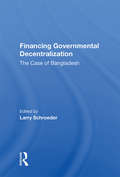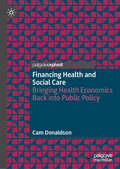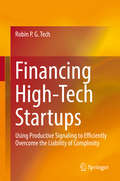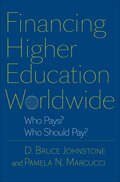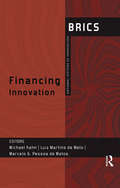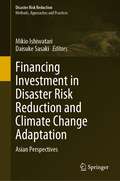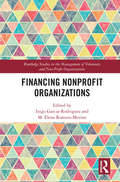- Table View
- List View
Financing Curtis LLP
by Nikolaos TrichakisThis is a follow-up case to "Curtis LLP: A Case on Cases." It explores the challenges facing debtors when dealing with borrowing firms that have operational flexibility.
Financing Economic Development in the 21st Century
by Sammis B. White Zenia Z. KotvalThe fully revised new edition of this textbook presents a well-balanced set of economic development financing tools and techniques focused on our current times of economic austerity. While traditional public sector techniques are evaluated and refocused, this volume emphasizes the role of the private sector and the increasing need to bring together different techniques and sources to create a workable financial development package. The chapters address critical assessments of various methods as well as practical advice on how to implement these techniques. New chapters on entrepreneurship, the changing nature of the community banking system, and the increasing need for partnerships provides critical insights into the ever-evolving practice of economic development finance.
Financing Education In A Climate Of Change (Twelth Edition)
by Vern R. Brimley Deborah A. Verstegen Rulon R. GarfieldThis is the eBook of the printed book and may not include any media, website access codes, or print supplements that may come packaged with the bound book. This new edition of the classic text in the field of school finance retains the practical tone and superior presentation that made the previous editions best sellers, while presenting the most up-to-date information and material available on key subjects. Here readers get a firm, balanced look of all facets of financing education, clarified and reinforced through numerous clear tables, figures, and key concept lists, and a tone and presentation that illustrates even the most difficult concepts. The new Twelfth Edition of Financing Education in a Climate of Change includes information on hot button topics such as the economics of education, recent court decisions 50-state comparison tables, the Common Core State Standards, and the ongoing debate about school vouchers, tax credits, and charter schools.
Financing Energy Efficiency: Lessons from Brazil, China, India, and Beyond
by Jeremy Levin Chandrasekar Govindarajalu Anke S. Meyer Robert P. Taylor William A. WardWhile energy efficiency projects could partly meet new energy demand more cheaply than new supplies, weak economic institutions in developing and transitional economies impede developing and financing energy efficiency retrofits. This book analyzes these difficulties, suggests a 3-part model for projectizing and financing energy efficiency retrofits, and presents thirteen case studies to illustrate the issues and principles involved.
Financing Failure: A Century of Bailouts
by Vern McKinleyDuring the recent financial crisis no issue has aroused more passion than financial institution bailouts.The standard rationale for the bailouts has been one of necessity and fear: federal regulatory agencies must have more authority in order to respond to the crisis, or else the public will face terrible consequences. But does this rationale hold up to close inspection? In Financing Failure, Vern McKinley approaches the topic by examining the policy decisions behind the bailouts and by showing their connection to previous government interventions. He brings under scrutiny the policy decisions made by the Treasury Department, the Federal Reserve, and the FDIC during the crisis of the 2000s and links them to policies that go back as far as the 1930s. This history of bailouts reveals that the genesis of financial crisis is government policy, be it the mismanagement of monetary policy during the 1930s or the political push to expand homeownership that helped cause the 2000s crisis. The nation&’s federal financial regulators and the politicians claim to have saved the American economy. In truth they have done everything within their power to expand their own influence—often far out of view from the public and media. Instead of openly explaining their actions, the bailout agencies have attempted to prevent the public from reviewing their decision-making, often at tremendous cost to taxpayers. McKinley&’s painstakingly researched and clear-headed analysis of bailouts and government intervention shows that the American public has accepted too many official pronouncements at face value, and that reining in the federal regulators is a necessary step toward truly promoting the safety and soundness of the financial system.
Financing Governmental Decentralization: The Case Of Bangladesh
by Larry SchroederOne policy goal of many developing countries is to decentralize public sector decision making so as to "bring it closer to the people." While discussions of decentralization commonly focus on how such policies can improve the effectiveness of resource allocation decisions, the issues of from where and how these resources are to become available are
Financing Health and Social Care: Bringing Health Economics Back into Public Policy
by Cam DonaldsonWhy do most capitalist economies have socialist health care systems? How can we preserve them? What would Aneurin Bevan think? These are the three main questions addressed by this book. In the 1950s, through In Place of Fear, Bevan made a strong case for a National Health Service which he had been instrumental in establishing in the UK in 1948. But he did not articulate the accompanying economic case. That case is presented here in an accessible way and extended to social care. A comprehensive understanding of &‘tried and tested&’ means of financing health care is presented, alongside assessments of repeated and new approaches proposed in policy circles as quick fixes to funding shortfalls. This is tackled across four themes: the role of the private sector; making choices in the face of resource scarcity; workforce planning and remuneration; and preparation for pandemics. The emerging proposals carry a cost to the public purse, but must be weighed against the costs and unfairness of further disintegration. With a special focus on the UK and the NHS at a critical time for policy change, this essential book provides the blueprint for policymakers, clinical leadership and politicians needing to pay more attention to the economic issues underlying health and social care as they shape In Place of Fear 2.0.
Financing Healthcare in China: Towards universal health insurance
by Sabrina Ching LukChina’s current social medical insurance system has nominally covered more than 95 per cent of 1.4 billion population in China and is moving towards the ambitious goal of universal health insurance coverage. Challenges posed by a rapidly ageing population, an inherently discriminatory design of the health insurance system, the disorder of drug distribution system and an immature legal system constrain the Chinese government from realizing its goal of universal health insurance coverage in the long run. This book uses a refined version of historical institutionalism to critically examine China's pathway to universal health insurance coverage since the mid-1980s. It pays crucial attention to the processes of transforming China's healthcare financing system into the basic social medical insurance system alongside rapid socio-economic changes. Financing Healthcare in China will interest researchers and government and think-tank officials interested in the state of healthcare reforms in China. Healthcare specialists outside of East Asia may also be interested in its general study of healthcare in developing countries. Scholars and students interested in the healthcare field will also find this useful.
Financing High Medical Risks: Discussions, Developments, Problems and Solutions on the Coverage of the Risk of Long-term Care in Norway, Germany and the Netherlands since 1945 in European Perspective
by K. P. CompanjeAcross the European Union, common problems and challenges have arisen related to the accessibility, quality, and financial sustainability of long-term healthcare services, which represent a new social and medical risk. This book compares national policies in Norway, Germany, and the Netherlands and how these countries approach issues such as old-age insurance, home-help programs,and mental healthcare. The contributors look at different paths of policy development, identify problems faced by public and private parties, and ultimately discuss possible solutions.
Financing High-Tech Startups: Using Productive Signaling To Efficiently Overcome The Liability Of Complexity
by Robin P. TechThis book examines the adverse effects of complexity, information asymmetries, transaction costs, and uncertainty on investors’ decision making. It suggests mitigating those effects using appropriate and matching signals, and analyzes a sample of 903 German startups to quantitatively highlight the distinct financing patterns and characteristics of high-tech startups. It then investigates the reasons for these patterns on the basis of a qualitative study that includes 34 interviews with investors and entrepreneurs in the US and Germany and an international expert panel. Lastly, it presents a framework that matches complexity factors with appropriate productive signals.
Financing Higher Education Worldwide: Who Pays? Who Should Pay?
by D. Bruce Johnstone Pamela N. MarcucciNo issue in higher education is as salient, or as controversial, as finance. As demand for higher education around the world grows, so do the costs associated with it, especially as governments shoulder less of the burden. Tuition fees rise and student loan debt grows. Who pays for these surging costs? Who should pay? D. Bruce Johnstone and Pamela N. Marcucci examine the universal phenomenon of cost-sharing in higher education—where financial responsibility shifts from governments and taxpayers to students and families. They find that growing costs for education far outpace public revenue streams that once supported it. Even with financial aid and scholarships defraying some of these costs, students are responsible for a greater share of the cost of higher education.Featuring comprehensive economic and policy data, the authors' international comparative approach shows how economically diverse countries all face similar cost-sharing challenges. So, who should pay for higher education? While cost-sharing is both politically and ideologically debated, Johnstone and Marcucci contend that, for almost all countries, it is imperative for the financial health of colleges and universities, bringing better efficiency, equity, and responsiveness. Financing Higher Education Worldwide combines sophisticated economic explanations with sensitive political and cultural analyses of the financial pressures facing higher education throughout the world.
Financing Higher Education in Africa
by World BankThe training and development of human capital in Sub-Saharan Africa (SSA) will help countries in the region diversify their economies, carry out economic transformation, and support sustainable growth. Higher education plays a key role in training qualified individuals who will be able to implement new technologies and use innovative methods to establish cost-efficient and effective enterprises and institutions. However, in order for SSA to reap the benefits of this investment in human capital, higher education institutions must secure financing to provide quality training and sound professional prospects to their students. Currently, tertiary education development is unsustainable-resources per student are declining and the quality of education is affected. These issues are particularly pressing in times of financial global crisis, when available resources for tertiary education tend to diminish. The impact of the crisis that started in 2008 provides a clear illustration of the need to explore innovative ways to diversify and secure financing for higher education in SSA. 'Financing Higher Education in Africa' provides a comprehensive overview of higher education financing in SSA. The book begins with an explanation of the fundamental problems faced by higher education institutions and students in SSA, namely the combined pressure of a rapid growth in demand and a growing scarcity of public resources, and it presents the dramatic consequences of these trends on quality. The book then turns to analyzing and comparing the current funding policies in SSA countries and it provides recommendations for improvement. Finally, the book examines the alternatives to the status quo and the policy tools needed to both diversify resources and allocate them based on performance. It will be of great interest to governments, universities, research institutions, and international organizations throughout the region.
Financing Higher Education: Answers from the UK
by Nicholas Barr Iain CrawfordThis topical volume tells the story of the UK debate on financing higher education, illustrating a head-on collision between the economic imperatives of student loans and regulated market forces, and the political imperative of 'free' higher education. In telling the story of the partnership of an economist and a political professional, the book offers lessons about both policy design and the politics of reform: of particular relevance to countries which have not yet addressed the issue, including many OECD countries, the more advanced post-communist reforming countries and, increasingly, to middle-income developing countries. No longer the exclusive province of a small intellectual elite, higher education is a key element in national economic performance. A modern economy needs a high-quality university system, and needs to make it accessible to everyone who can benefit, but mass higher education is expensive, and competes for public funds with pensions and health care, to say nothing of nursery education and schools. How to pay for higher education has thus become a central issue, and Barr and Crawford’s book expertly covers the debates and issues involved.
Financing India's Imperial Railways, 1875–1914 (Perspectives in Economic and Social History #14)
by Stuart SweeneyThe Indian railway network began as a liberal experiment to promote trade and commerce, the distribution of food and military mobility. Sweeney's study focuses on Britain's largest overseas investment project during the nineteenth century, offering a new perspective on the Anglo-Indian experience.
Financing Innovation: BRICS National Systems of Innovation
by Michael Kahn; Luiz Martins de Melo; Marcelo G. Pessoa de MatosThis series of books brings together results of an extensive research programme on aspects of the national systems of innovation in the five BRICS countries – Brazil, Russia, India, China, and South Africa. It provides a comprehensive and comparative examination of the challenges and opportunities faced by these dynamic and emerging economies. In discussing the impact of innovation with respect to economic, geopolitical, socio-cultural, institutional, and technological systems, it reveals the possibilities of new development paradigms for equitable and sustainable growth.This volume analyses the financing of science, technology and innovation in the BRICS economies. It highlights the importance of institutional coordination and the influence of implicit policies on the extent to which capital markets may contribute to innovation financing. It stresses the role of state development banks and similar organisations in promoting high-risk and long-run building of innovative capacities with respect to development strategy. Original and detailed data, together with expert analyses on wide-ranging issues, make this book an invaluable resource for researchers and scholars in economics, development studies and political science, in addition to policy-makers and development practitioners interested in the BRICS countries.
Financing International Trade: Banking Theories and Applications
by Gargi SanatiThis first-of-its-kind textbook presents an overview of the fundamental nature and regulatory structure of forex transactions operating within the Indian banking system. Though international trade theory is well discussed in academic circles, trade finance is often viewed as the prerogative of bankers, financers and professionals. However, with the increase in cross-border expansion of trade, financial aspects of international trade has turned out to be one of the key components of various educational programs, at both undergraduate and post-graduate levels. This textbook discusses different types of forex transactions, the regulatory framework within which they take place and the associated risks and solutions. It tries to resolve the existing disparity in the understanding and interpretation of regulatory guidelines and the practices adopted by banks and corporates in implementing them. The cases and examples, integrated throughout the chapters, are coupled with resolutions to the problems discussed and substantial explanation of the underlying principles. Key Features • Caselets and problem definitions weaved throughout the chapters to aid understanding of forex in different realms • Discussion on the roles of institutions other than banks and corporate houses such as RBI, FEDAI, ECGC and DGFT in international trade finance • Ideal companion for students of international finance, international banking, forex business and trade finance, financial markets and others
Financing Investment in Disaster Risk Reduction and Climate Change Adaptation: Asian Perspectives (Disaster Risk Reduction)
by Mikio Ishiwatari Daisuke SasakiAs the population is growing and urbanization is progressing, higher numbers of people are exposed to disaster risks, especially in the developing countries. Climate change is further worsening the impacts of existing risks and introducing new ones. It is imperative that countries need to invest more in disaster risk reduction (DRR) as well as climate change adaptation (CCA) not only to minimize their impacts but also to build resilience.To date, various international arenas have recommended increasing investment in DRR. The Sendai Framework for DRR, adopted by the UN member states in 2015 during the Third UN World Conference on DRR, emphasizes investment as a priority for decreasing disaster risks and losses. The Yangon Declaration set the goal of doubling investment to address water-related disasters. However, most countries are not able to proactively invest enough in DRR. Understanding the current scale and estimate of investment and its effects is crucial for promoting DRR investment, but such information and estimates are rarely available.This book examines the current investment trends and issues in DRR and CCA. Based on specific case studies, field data and evidence, the book identifies challenges in increasing investment and recommends various investment policies and innovative approaches to sustainable progress towards a resilient future.Chapter 12 is available open access under a Creative Commons Attribution 4.0 International License via link.springer.com.
Financing Life Science Innovation
by Alexander StyhreThe life sciences are widely treated as a field and an industry with high-growth potential, and while neoclassical economic theory prescribes that capital are invested in emerging industries, there is a perceived shortage of venture capital among life science entrepreneurs. Financing Life Science Innovation reviews the literature on venture capital, corporate governance, and life science venturing and presents a study of the Swedish life science industry and the venture capital investors being active in financially and managerially supporting life science start-up firms. The study reveals that venture capital investors, life science entrepreneurs, and innovation system actors today face the challenge of supplying adequate amounts of capital to an industry that may produce tomorrow's health care innovations. Changes in scientific research practices, the structure of the international finance market, and industry policy are all contributing to what is frequently treated as a shortage of venture capital in the life sciences.
Financing Medicine: The British Experience Since 1750 (Routledge Studies in the Social History of Medicine #Vol. 24)
by Martin Gorsky Sally SheardFinancing Medicine brings together a collection of essays dealing with the financing of medical care in Britain since the mid-eighteenth century, with a view to addressing two major issues: Why did the funding of the British health system develop in the way it did? What were the ramifications of these arrangements for the nature and extent of health care before the NHS? The book also goes on to explore the 'lessons' and legacies of the past which bear upon developments under the NHS. The contributors to this volume provide a sustained and detailed examination of the model of health care which preceded the NHS - an organization whose distinctive features hold such fascination for the scholars of health systems - and their insights illuminate current debates on the future of the NHS. For students and scholars of the history of medicine, this will prove essential reading.
Financing Nature-Based Solutions: Exploring Public, Private, and Blended Finance Models and Case Studies (Palgrave Studies in Impact Finance)
by Robert C. BrearsThis book presents new research on innovative financial instruments and approaches available to implement nature-based solutions (NBS) at various scales and in different contexts. Despite knowledge of the multiple benefits NBS provide, a key barrier to their wide-spread adoption is a lack of knowledge over their financing, in particular, who should pay for an NBS and how it can be financed. The book explores a variety of public, private, and blended finance models and their applicability in developing NBS across terrestrial and marine ecosystems, involving multiple stakeholders, and in jurisdictions of varying climates and income levels. Furthermore, the book provides case studies of the innovative financing of NBS with best practices identified. This book is of interest to environmental planners, resource conservation managers, policymakers, international companies and organizations, environmental NGOs, researchers, and graduate and undergraduate students interested in NBS.
Financing New Ventures
by Ramana Nanda William R. KerrAid in understanding of financing entrepreneurship.
Financing Nonprofit Organizations (Routledge Studies in the Management of Voluntary and Non-Profit Organizations)
by Inigo Garcia-Rodriguez M. Elena Romero-MerinoThe financial issues of nonprofit organizations (NPOs) have increased their importance in recent years, especially after the last global economic downturn. In this way, NPOs have been threatened by a reduction of income, while their work and expenses have not decreased. In this book, the editors bring together several topics that the academic literature has previously addressed, connecting them to each other and evaluating how all these issues are interrelated. Financing Nonprofit Organizations analyses the state of art of all these financial topics and the consequences of the last economic crisis. It dives into the interrelations of these concepts to suggest lines of future research and to reflect on the future of the different sources of funding of the NPOs. It will be of interest to students, practitioners, and researchers interested in initiating and updating their knowledge in the growing field of the financial aspects of the NPOs.
Financing Nonprofits: Putting Theory into Practice
by Dennis R. YoungEleven American academics contribute 15 chapters examining which combinations of income best support the performance of a nonprofit organization seeking to address a given social mission in a particular set of circumstances. Coverage includes distinct sources of income that can support nonprofit operations--individual giving, institutional philanthropy, government funding, fee income and commercial ventures, membership income, investment income, and volunteer resources--and the circumstances under which each is appropriate; sources of capital for nonprofit organizational development and programming, including collaboration and barter, gifts-in-kind and other illiquid assets, and borrowing and debt; and overall portfolio and performance issues such as managing endowment and other assets, income portfolios, and measuring financial health and vulnerability. Annotation ©2007 Book News, Inc. , Portland, OR (booknews. com)
Financing Operations and Growth: Funding the Different Stages of Growth
by Harvard Business School PressCompanies that are experiencing growth face the challenge of finding the financing to support it. This chapter describes various combinations of internally generated funds and external financing. Using eBay as a case study, the chapter examines these methods of financing growth through different phases in the life cycle of business enterprises.
Financing Our Foodshed: Growing Local Food with Slow Money
by Carol Peppe Hewitt“[Hewitt] paints an engaging portrait of a community learning how to take care of its own, and offers inspiration for others looking to do the same.” —Amy Cortese, author of LocavestingIn towns and cities across North America, a quiet revolution is underway. Fed up with sending their money off to make a fast buck in faraway markets, people are putting their money to work where they live, in markets they trust and understand—starting with food.Financing Our Foodshed is a collection of real-life stories of these Slow Money pioneers and the local food entrepreneurs—sustainable farmers, bakers, restaurateurs, and more—they have chosen to support.Fueled by their desire to do more than just eat local food, lenders of “nurture capital” are making low-interest, peer-to-peer loans to the people who produce, process, distribute and sell local food. Meet these passionate food entrepreneurs like:Abi, talented artist-turned-baker, who borrowed the funds to start a gluten-free bakeryAngelina, owner of a Greek local foods restaurant, who refinanced exorbitant credit card debt incurred by renovationsChatham Marketplace, a much-loved grocery co-op whose monthly loan payments were reduced by a third, thanks to an ambitious collaboration between 16 investorsFinancing Our Foodshed tells the compelling stories of ordinary people doing something extraordinary, and will appeal to anyone who understands the critical importance of sustainably grown local food and resilient local economies, and wants a blueprint to get us there.“For anyone seriously interested in boosting his or her community’s economy—including politicians, policymakers, financiers, businesspeople, and activists—this book is essential reading.” —Michael H. Shuman, author of Put Your Money Where Your Life Is





